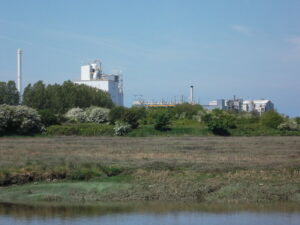PFAS: Major pollution concerns at the Hillhouse Technology Enterprise Zone – Thornton-Cleveleys
Groundsure article – PFAS: Major pollution concerns at the Hillhouse Technology Enterprise Zone – Thornton-Cleveleys.

Headlines that shout ‘Residents told to wash and peel homegrown vegetables before eating’ are going to cause concern. And when it signals the potential for a new Part 2A site it is worth taking note and understanding the origin of the headlines. In this blog, we explore the site’s history that has led to serious contamination by the “Forever Chemicals” PFAS.
Hillhouse Enterprise Zone, located on the River Wyre, Thornton-Cleveleys, near Blackpool has had a busy industrial history. Fleetwood Salt Company developed works to process the salt from the Preesall salt mines in the 1890s. In 1926 ICI (Imperial Chemical Industries) was formed and took over operation of the site from the United Alkali Company.
In the early twentieth century it started to produce chlorine gas for the war effort, producing almost 90,000 tonnes a year at Hillhouse. It later evolved into a major site for ICI. Over time, it became a significant industrial complex, producing plastics, chemicals and other heavy industrial processes.
However, after the decline of chemical manufacturing in the region and ICI’s withdrawal in 1999, parts of the site fell into disrepair, with a few facilities in ongoing and maintained operation. The legacy of heavy industry left significant environmental challenges, including soil and water contamination from years of chemical production. This posed a major obstacle for redevelopment efforts, but the site is progressing through the normal planning process. So where does the concern arise?
The problem comes from PFAS (Per and Poly FluoroAlkyl Substances), a fluorine-containing family of “wonder” chemicals. They are only now beginning to be understood for their impact on human health and the wider environment. It is causing significant concern in the assessment of contaminated sites with lack of understanding about their toxicity, behaviour in the environment and within people. A major concern is that we do not have an easily translatable range of reliable remedial measures because of their unusual characteristics.
What are PFAS?
PFAS are a large group of synthetic chemicals developed in the 1940s.They are known for their durability, resistance to heat (think fire-proofing furniture and fire-fighting foam) and non-stick properties (think clothing waterproofing, lining of disposable takeaway boxes and Teflon cookware). As a result, they are found in a huge range of products; household and industrial.
Why is PFAS a problem?
So far, so positive. However, they have other attributes that make them problematic. Some of the PFAS family of chemicals have been found to be carcinogenic, potentially at very low concentrations; they are very water soluble, so capable of spreading fast and widely in the environment. Finally, they are persistent, meaning they bioaccumulate in the food chain earning them the name ‘Forever Chemicals’ and resulting in some of them being detected from the Arctic to Antarctic.
How much do we know about PFAS?
PFAS comprises thousands of individual compounds, each with their own characteristics. Two have been the focus of most study: perfluorooctanoic acid (PFOA) and perfluorooctane sulfonate (PFOS) both of which have raised significant health and environmental concerns.
PFAS are associated with various health risks, including potential cancer risks, liver damage, immune system impacts, and developmental issues in infants and children. These health concerns are redoubled because PFAS are bioaccumulative. Prolonged exposure to PFAS could potentially lead to severe health issues.
Studies have linked exposure to some of the PFAS family to immune system suppression, thyroid hormone disruption, and certain cancers, particularly liver and kidney cancers. This is just the human impact: the environmental impact is very poorly understood.
So why do local people need to wash and peel their homegrown vegetables in Thornton-Cleveleys now?
The source of the concern is a local user of PFOA-related products. These include various fluoropolymers, which have high-temperature resistance and are used in everything from solar panels to medical devices. PFOA as an additive was used until it was phased out in 2012. The operations were first permitted to ICI by Her Majesty’s Inspectorate of Pollution in 1994 and then transferred to Asahi Glass Fluoropolymers UK Limited then AGC Chemicals Europe Ltd on the permits which have been amended with the evolving regulatory framework. These permits have been regulated and compliant.
During this time, it has discharged significant quantities of PFOA to air, land and water.
The Guardian reports that correspondence between AGC Chemicals and the Environment Agency states:
“AGC says 49.1 tonnes would have been emitted into the air, 54.3 tonnes to water, 6.2 tonnes to landfill, 5.1 tonnes incinerated and 63.3 tonnes would have been sent to customers.’
The site was featured in the documentary ‘TOXIC’ which reported laboratory testing with extremely high levels of PFOA in the samples. Although AGC has phased this chemical out before a global ban, the PFOA is still in the discharge as a result of legacy pollution.
The issue of wider PFAS compounds remains thorny as AGC continues to use another PFAS additive called EEA-NH4. This is legal, but the Environment Agency has stated that the chemical is very persistent and toxic as it can be harmful to fertility and development.
Conceptual Site Model
So now it becomes more apparent why local residents are being asked to be cautious of their homegrown produce. The emissions to air will have come to ground in the vicinity either through precipitation or dust and because of PFOA solubility it will be more readily transported through the soil and into plants.
As we have seen already there is concern that PFAS is bioaccumulative. Other pathways also likely to be considered are lateral movement through groundwater as the underlying geology is confirmed by BGS borehole records as Made Ground (1.2m) over ‘Boulder Clay’ (interbedded silty clay with gravel and sand) to 30m.
However, there are no local water abstractions. More likely are concerns relating to the protected ecological sites on the Wyre Estuary and Morecambe Bay, particularly with the longstanding discharges to the River Wyre combined with PFOA persistence. This has potential implications for the sediments in the wider area and any ecology relying on them.
What is happening now?
The Environment Agency has begun to assess the risk from PFAS across the UK and selected subject sites, including this one, as the initial cohort. This has triggered Wyre Council to identify the site as a potential Part 2A designated site and because of the type of site and contamination has handed the site across to the Environment Agency and UK Health Security Agency (UKHSA) who will be progressing the investigations.
What to expect?
We can expect PFAS research to start influencing the conversation and leading to new guidelines for their assessment and evolving regulation. This case study will no doubt be part of the process. Before the process fully develops, it is likely that new sites will be designated as Part 2A (contaminated land), including some that have already been cleaned up, but where PFAS was not initially considered.
This may also affect development projects already in progress, requiring re-evaluation and additional remediation before conditions are approved. In response, new and improved techniques for cleaning up PFAS will emerge, making remediation more efficient and cost-effective.
How can Groundsure help?
We are already adapting our consultant-reviewed risk assessments to ensure that our reports reflect the potential legacy risks from contamination. This will continue to evolve as more is discovered about the impact and behaviour of this group of chemicals. The investigation at Hillhouse will no doubt be part of those learnings.
Our Insights data provides information about the potential sources of PFAS as well as allow you to formulate your site-specific context to understand the plausible pathways that may need to be addressed. If you would like to contribute to our understanding of how you would like to see the data on PFAS served please contact us at [email protected]
Ceri Sansom, Groundsure.
Background reading
Remediation of poly- and perfluoroalkyl substances (PFAS) contaminated soils — To mobilise or to immobilise or to degrade? Bolan N et al. J Hazard Mater. 2021 Jan 5; 401: 123892.
References:
https://www.visitcleveleys.co.uk/about/business/hillhouse-enterprise-zone
https://www.wyre.gov.uk/multi-agency
https://www.sciencedirect.com/science/article/pii/S0013935123025471#bib14
Kindly shared by Groundsure


















